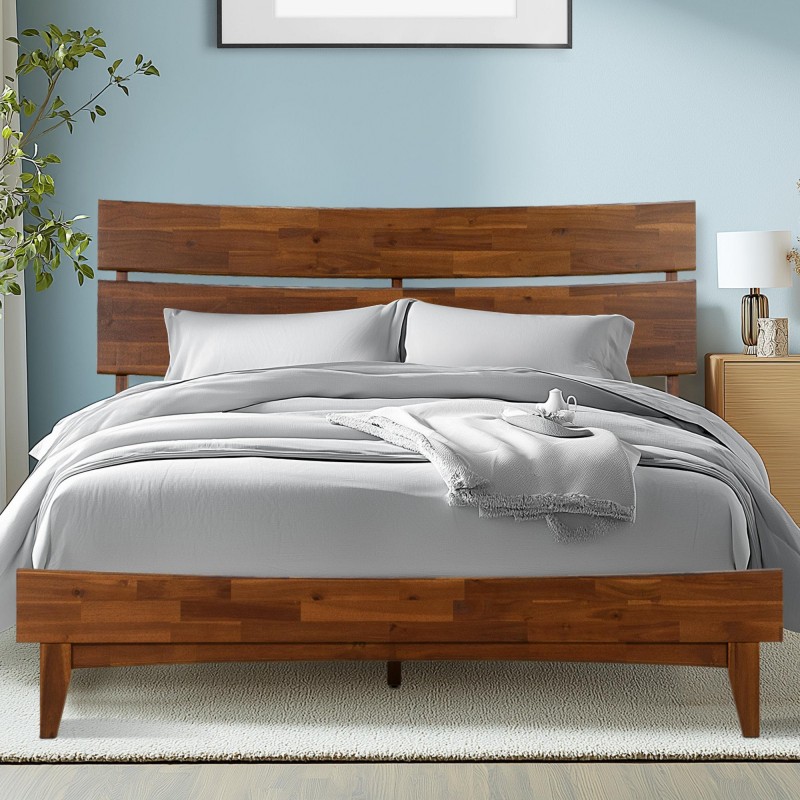Choosing the right bed size is a critical decision for creating a comfortable and restful sleeping environment. Among the many options available, two of the most popular sizes are queen and king-size beds. While both provide ample space for sleeping, there are significant differences between queen and king-size beds that might make one more suitable for your specific needs than the other. Understanding these differences goes beyond just the dimensions; it also involves considering factors like room size, budget, and personal preferences. This article will delve into the various aspects of queen and king-size beds, exploring their dimensions, suitability for different sleeping styles, cost considerations, and the impact on room aesthetics. By the end, you will clearly understand which bed size is best for you and your bedroom layout.
Dimensions: A Closer Look
The most apparent difference between queen and king-size beds lies in their dimensions. Knowing these measurements is essential for ensuring that the bed fits comfortably in your space.
1. Queen Size Bed Measurements
A standard queen-size bed measures 60 inches wide by 80 inches long. This size offers enough space for two adults to sleep comfortably while not taking up too much room, making it a popular option for couples or single sleepers who enjoy extra space.
2. King Size Bed Measurements
A standard king-size bed measures 76 inches wide by 80 inches long. This size provides significantly more width than a queen, making it an ideal choice for couples who desire more personal space while sleeping. The dimensions of a king-size bed allow for generous stretching and movement without disturbing your partner.
3. California King
It’s also essential to note that there is a variant known as the California king-size bed. The dimensions for this size are 72 inches wide by 84 inches long. While it is narrower than a standard king bed, it is longer, catering to taller individuals who need the extra legroom.
Space Considerations: Finding the Right Fit
When deciding between a queen and king-size bed, considering the size of your bedroom is crucial.
1. Room Size
Queen-size beds are often better suited for smaller bedrooms, while king-size beds require more space to accommodate their larger footprint. An ideal bedroom size for a queen bed is typically around 10 feet by 10 feet, whereas a king bed is better in a space measuring at least 12 feet by 12 feet.
2. Clearance for Movement
Beyond the bed’s dimensions, it’s important to ensure there’s enough space around the bed for movement and additional furniture. Ideally, you should leave at least two feet of walking space around the bed for ease of access.
3. Layout Considerations
Think about the overall arrangement of your bedroom furniture. The position of windows, doors, and existing furniture can affect how you place the bed. A king-size bed may limit your options for effective room layout, especially in smaller spaces.
Comfort Levels: Evaluating Sleeping Needs
Different bed sizes can impact comfort levels based on sleeping preferences and habits.
1. Sharing the Bed
For couples, the extra width offered by a king-size bed often leads to a more comfortable sleeping experience. It reduces the chances of disturbing each other’s sleep when moving. In contrast, a queen bed provides adequate space, but some may feel cramped, especially if both partners are restless sleepers.
2. Individual Sleep Styles
Consider how you and your partner sleep. If one or both of you tend to sleep sprawled out or shift during the night, a king-size bed might suit your needs better. Queen beds may be more suitable for individuals or couples who prefer a cozy sleeping space.
3. Mattress Options
The types of mattresses available can also affect comfort. Queen-size mattresses offer a wide variety of options, including memory foam, innerspring, and hybrid varieties, while king-size mattresses can also feature luxury or specialty options designed to enhance support and comfort.
Cost Considerations
Budget often plays a crucial role in choosing between queen and king-size beds. The initial purchase cost can vary significantly based on size, but additional factors also contribute.
1. Mattress Prices
Generally, king-size mattresses are more expensive than queen sizes due to the larger materials involved. You can expect to pay a premium for a high-quality king mattress. However, both sizes offer varied pricing, so it’s essential to compare models and features before making a decision.
2. Bedding Costs
When selecting a bed size, don’t forget to consider the costs associated with bedding. Sheets, blankets, and comforters for king-size beds are often more expensive than their queen-size counterparts, which may add to your budget.
3. Furniture Investment
If transitioning to a king-size bed, be aware that you may need new bedroom furniture or a larger bed frame. Ensure you factor in these costs as part of your overall investment.
Aesthetic Impact: The Visual Appeal of Bed Size
Choosing between a queen and king-size bed can also influence the room’s aesthetic. The bed often serves as the focal point of a bedroom and contributes greatly to its overall design scheme.
1. Visual Balance
A king-size bed provides a grand statement piece and can work well in spacious bedrooms, adding an elegant touch. However, in smaller rooms, a queen-size bed can create a cozy atmosphere that feels inviting without being overwhelming.
2. Style Complementation
Consider how either bed size complements the existing decor. If you have vintage or minimalist styles, both queens and kings can fit, but the style of bedding (sheets, comforter, pillows) you choose can further enhance the aesthetic.
3. Decorative Options
When decorating a larger bed, there’s more room to experiment with pillows and bedding layers, allowing for fun possibilities in creating visually appealing arrangements.
Additional Functional Considerations
When selecting between a queen and king-size bed, additional functional factors can influence your decision.
1. Accessibility
Accessibility becomes crucial if you have mobility issues or elderly family members. A lower bed height may be easier to get in and out of. Take this into account, especially for king-size mattresses that can be taller or bulkier.
2. Pet Companions
If you have pets that share the bed, the extra space provided by a king-size bed ensures that they can comfortably settle without imposing on the partners’ resting space.
3. Bed Frame Design
The type of bed frame you select can also affect the functionality of the bed. For heavier king-size mattresses, ensure your chosen frame adequately supports the weight while providing the right level of comfort and height.
Conclusion
Choosing between a queen and king-size bed requires careful consideration of various factors, all revolving around your personal needs and preferences. Understanding the differences between queen and king-size beds allows you to make an informed decision that perfectly fits your lifestyle and living space.
In addition to size, consider how factors such as comfort, cost, aesthetic appeal, and functionality come into play. With the right information and guidance, you can confidently invest in a bed that will provide you with a restful night’s sleep for years to come. Ultimately, whether you choose a queen bed for a cozy experience or opt for a king for spacious slumber, being aligned with your preferences will lead to a happier and more comfortable sleep environment.
By embracing the knowledge gained throughout this exploration, you can enjoy the benefits of a well-chosen bed, experiencing the joy and satisfaction of a perfect night’s sleep, tailored to meet your unique requirements.